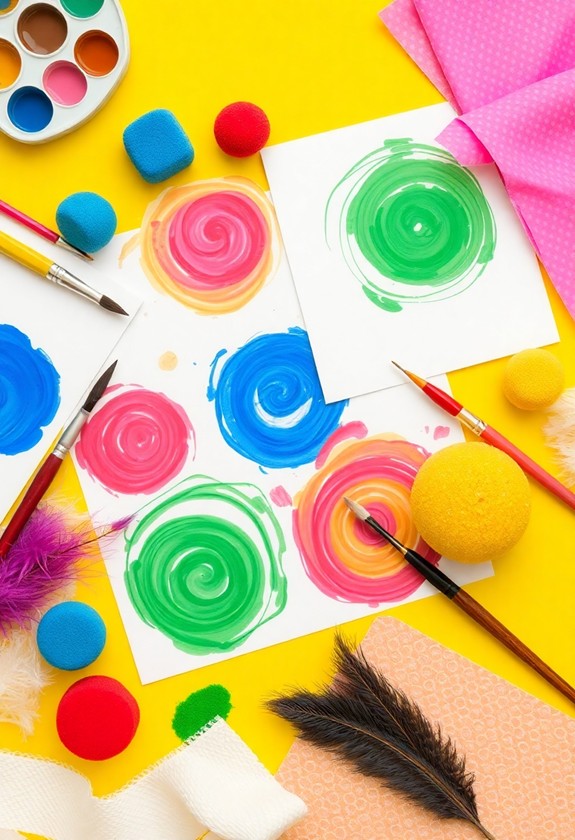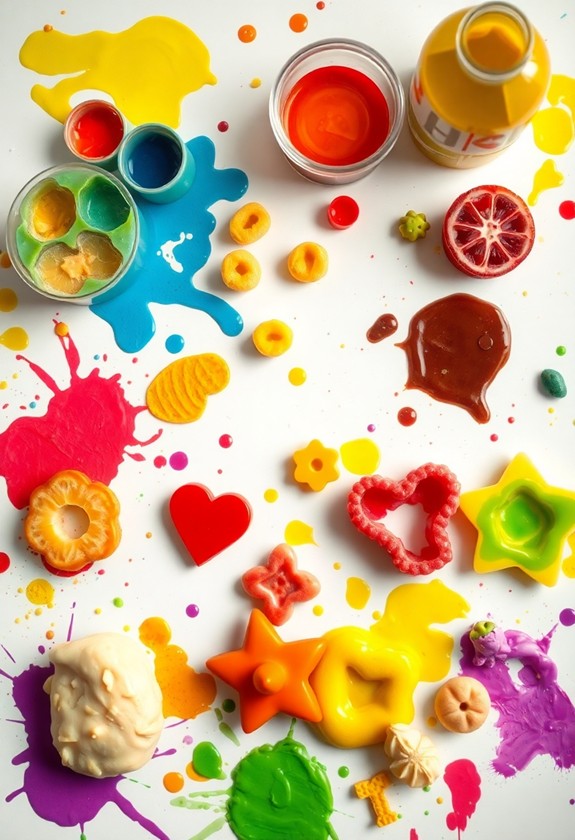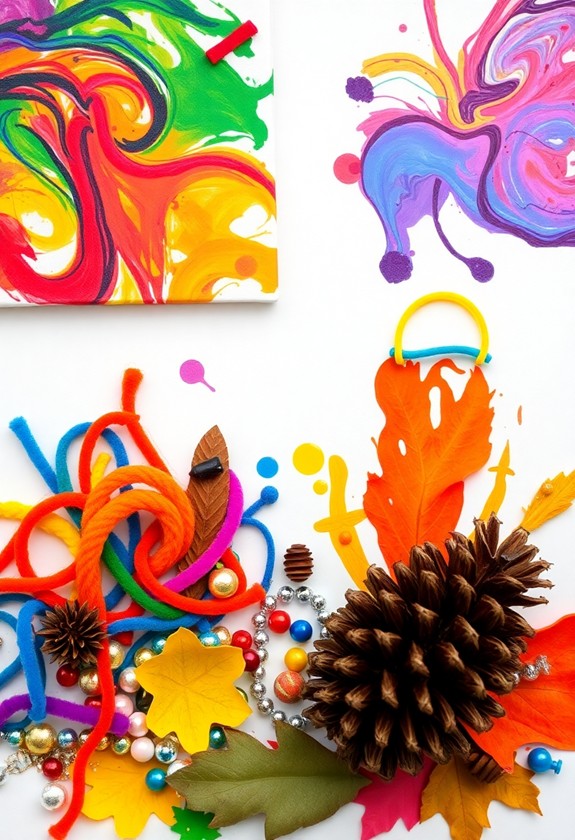Boost your toddler's language skills with these 8 exciting sensory art activities! Engage with colorful finger painting, create textured collages, and sculpt with scented play dough. Let sounds inspire artwork, and whip up taste-safe edible masterpieces. Hunt for treasures in a sensory bin, investigate light and shadows through drawing, and collect nature's wonders for artsy projects. These hands-on activities engage multiple senses, sparking curiosity and encouraging descriptive language. Your little one will love getting messy as they learn new words and concepts. Plus, you'll both have a blast bonding over these creative adventures! Want to unlock even more language-boosting potential? There's a world of sensory discovery waiting for you!
Creative Highlights
- Finger painting promotes language development through descriptive conversations about colors, textures, and shapes.
- Textured collage creation enhances sensory awareness and vocabulary related to different materials and sensations.
- Scented play dough sculpting supports memory retention and expands vocabulary through smell-based guessing games.
- Nature walk art collection encourages imaginative language use and sensory engagement with outdoor elements.
- Sound-inspired artwork introduces new vocabulary and enhances communication skills through auditory-visual connections.
Finger Painting Color Exploration

Plunge into a world of lively hues with finger painting color exploration! This messy, magical activity will have your toddler giggling with glee as they learn about colors and textures. Here's how to get started:
- Gather supplies: non-toxic finger paints, large paper, and a splash mat
- Set up a colorful workspace
- Let your little one jump right in!
For a safe DIY alternative, try homemade paint recipes using kitchen ingredients like flour and natural food colorings. These options are non-toxic and easy to clean up, perfect for worry-free creative sessions.
Watch as they squish, smear, and swirl the paints, creating a rainbow of fun! Encourage them to mix colors and see what happens. "Look, you've made orange!" As they play, chat about the colors, textures, and shapes they're creating. Ask questions like, "What does the paint feel like?" or "Can you make a big, blue circle?"
This hands-on experience isn't just artsy – it's a language-boosting bonanza!
Textured Collage Creation
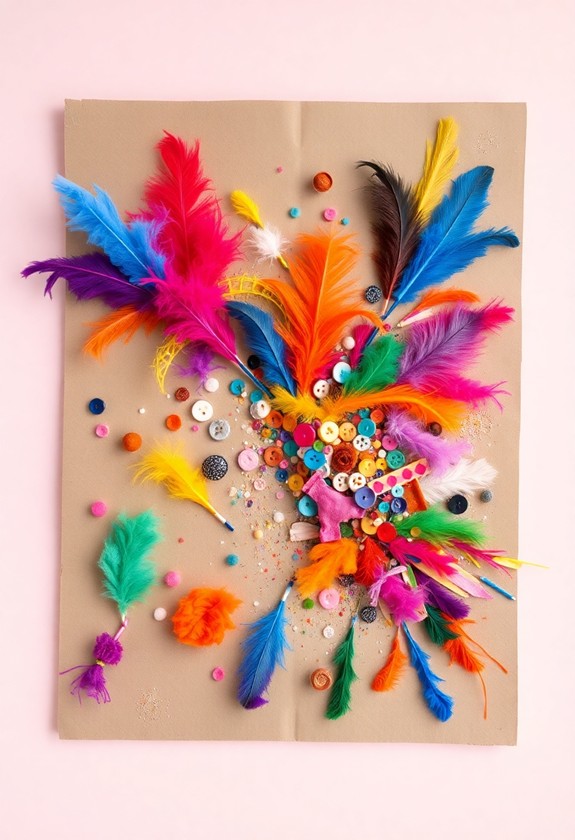
A textured collage creation offers your toddler a tactile adventure in art. It's a fantastic way to engage their senses and boost language skills! This activity not only improves fine motor skills but also promotes cognitive development through sensory investigation. Gather a variety of materials with different textures: soft cotton balls, rough sandpaper, smooth fabric, crinkly tissue paper, and more. Let your little one investigate each item, encouraging them to describe what they feel.
Now, it's time to get sticky! Help your toddler apply glue to a sturdy piece of paper. Then, let them go wild sticking on their chosen textures. As they create, ask questions like:
- "How does that feel?"
- "What color is this?"
- "Can you find something bumpy?"
This activity isn't just fun – it's a sensory bonanza! Your child will learn new words, practice fine motor skills, and express their creativity. Plus, you'll end up with a touchable masterpiece!
Scented Play Dough Sculpting
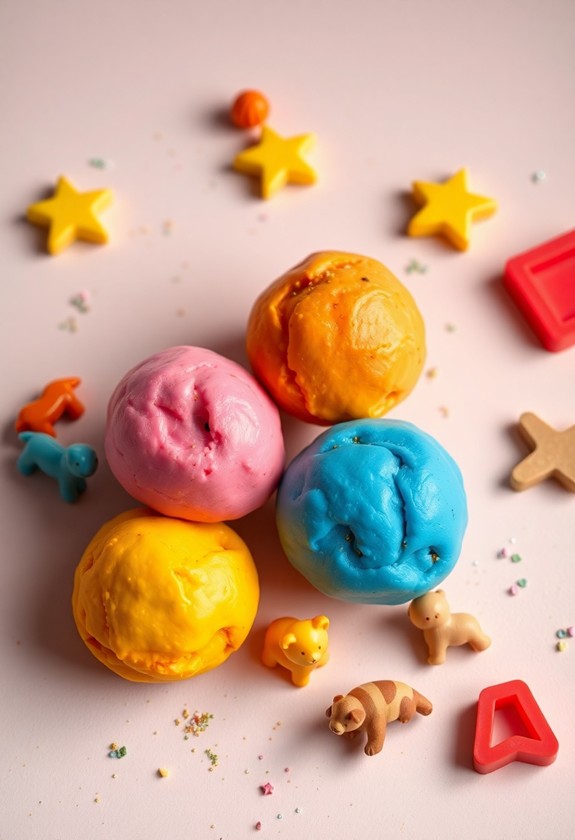
Bursting with aromatic possibilities, scented play dough sculpting offers a multi-sensory experience for your toddler. It's a fantastic way to engage their senses and boost language skills! Multi-sensory experiences aid in memory retention and information processing, vital for early childhood development. Here's how to get started:
- Mix up homemade play dough with your little one
- Add delightful scents like vanilla, lavender, or cinnamon
- Let the sculpting begin!
As your toddler squishes, rolls, and molds the dough, encourage them to describe what they're doing. Ask questions like, "What does it smell like?" or "How does it feel?" This sensory-rich activity will have them chattering away in no time!
Pro tip: Create a "scent guessing game" by hiding different scents in separate batches. It's a nose-tastic way to expand their vocabulary and have a ball!
Sound-Inspired Artwork
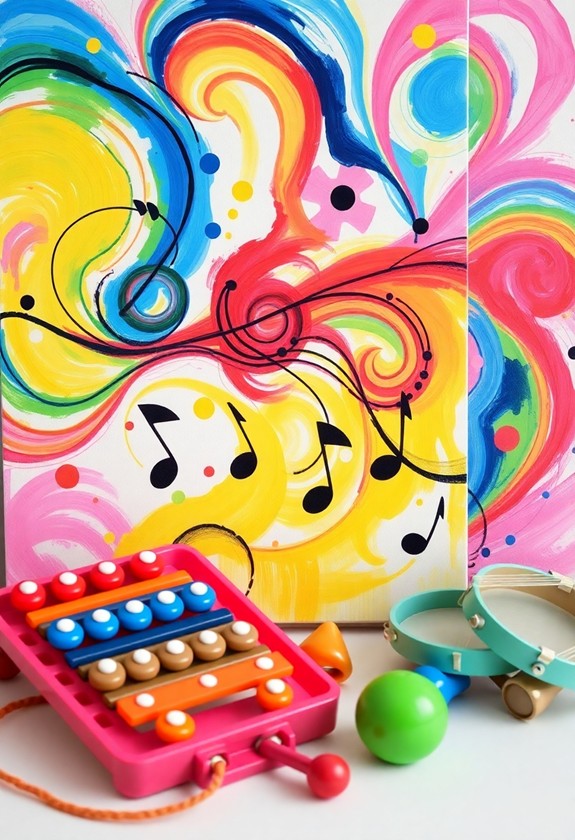
Ever wondered how to transform sound into visual art with your toddler? Get ready for a sound-sational adventure! Here's how to create sound-inspired masterpieces:
- Gather supplies: paper, paint, and noisemakers (bells, shakers, drums)
- Play different sounds and ask your little one to paint what they hear
- Try these fun ideas:
- Loud sounds = big, bold strokes
- Soft sounds = gentle, wispy lines
- Fast rhythms = quick dots and dashes
- Slow melodies = long, flowing curves
This activity not only improves creativity but likewise develops fine motor skills vital for later academic success. Using washable, non-toxic paints can make this a mess-free and safe experience for your toddler.
Encourage your toddler to describe their artwork. "What does this squiggly line represent?" This activity isn't just fun, it's a language booster! As they listen, create, and explain, they're developing significant communication skills. Plus, it's a great way to introduce new vocabulary. So, let's make some noise and turn those sounds into spectacular sights!
Taste-Safe Edible Art
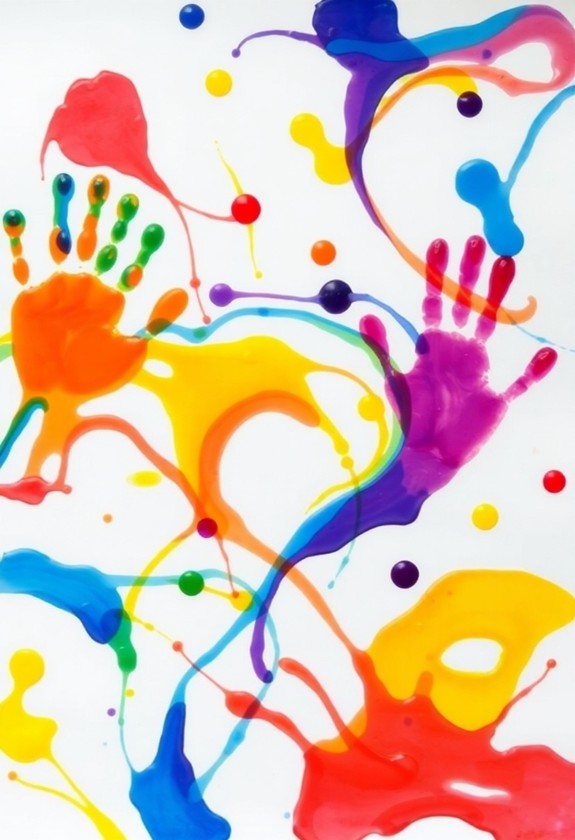
Hungry artists, rejoice! It's time to investigate the delicious world of taste-safe edible art. You'll love these yummy creations that are safe for your little one to munch on as they create! These activities not only promote creative expression but also improve fine motor skills and color recognition in toddlers.
Start with a tasty canvas:
- Spread peanut butter on whole-wheat bread
- Use a rice cake as a base
- Smear yogurt on a paper plate
Now, let's add some colorful, edible "paint":
- Mashed berries
- Pureed veggies
- Food coloring mixed with cream cheese
Encourage your toddler to finger paint, splatter, or use utensils to create their masterpiece. Watch as they reveal new textures, tastes, and colors! But wait, there's more! Try making 3D sculptures with cheese cubes or fruit chunks. The possibilities are endless, and clean-up is a breeze – just eat the evidence!
Sensory Bin Treasure Hunt
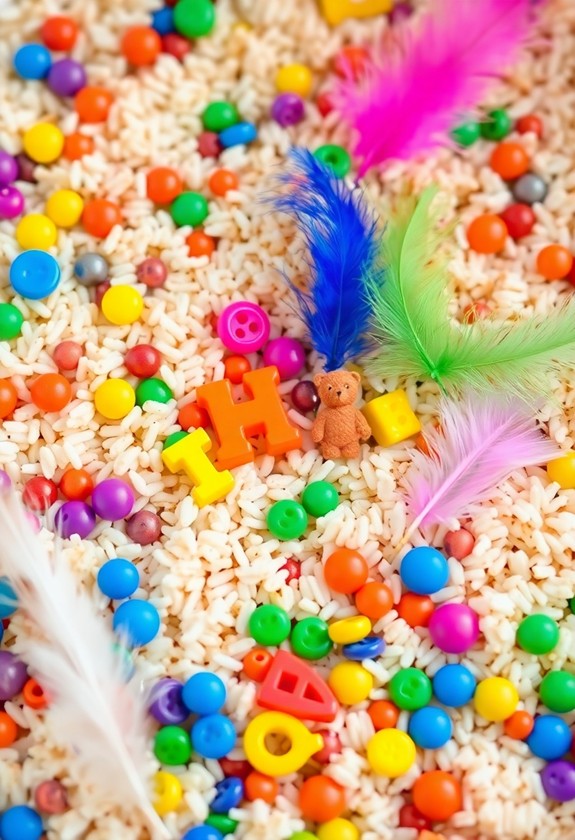
From edible creations to hidden treasures, let's explore the exciting world of sensory bin treasure hunts. Get ready for a thrilling adventure that'll engage your toddler's senses and boost their language skills!
Here's how to create a sensory bin treasure hunt:
- Fill a large container with a base material (rice, sand, or beans).
- Hide small toys, letters, or objects in the base.
- Give your child a list of items to find (use pictures for non-readers).
- Encourage them to dig, scoop, and search!
As they hunt, ask questions like "What do you feel?" or "Can you describe the texture?" This activity is a sensory sensation that'll have your little one babbling with excitement! Plus, it's a great way to introduce new vocabulary and practice problem-solving skills. Get ready to dig into some serious fun!
Light and Shadow Drawing
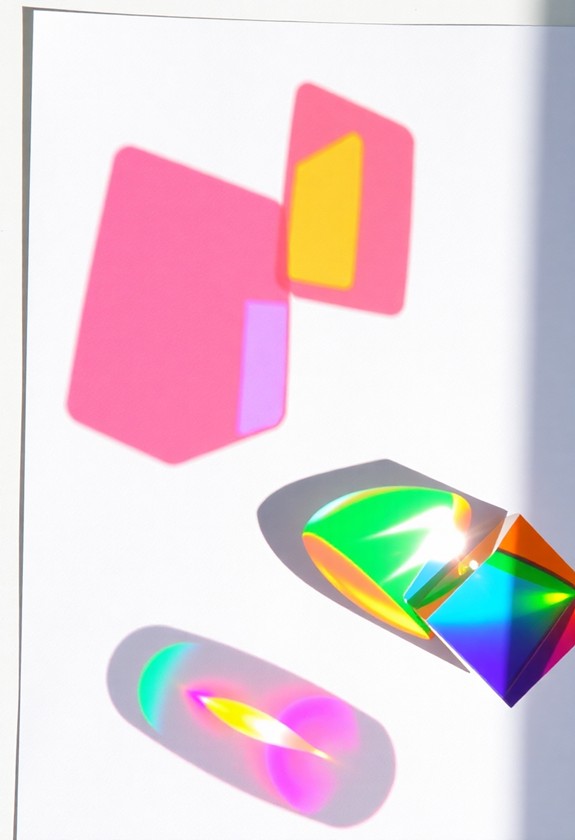
Uncover the fascinating world of light and shadow with this engaging drawing activity for toddlers. It's time to turn off the lights and get creative! Grab a flashlight, some paper, and your little one's favorite toys. Watch your child's eyes light up as they investigate the magical shadows cast by their playthings!
Here's how to make it happen:
- Place a toy on the paper and shine the flashlight from different angles
- Let your toddler trace the shadow with crayons or markers
- Experiment with various objects to create unique shadow shapes
This activity isn't just fun—it's a language-boosting bonanza! Encourage your child to describe the shadows, use action words, and compare sizes. They'll be shadow-savvy in no time! Plus, it's a great way to introduce scientific concepts like light and perspective. Get ready for some illuminating conversations!
Nature Walk Art Collection
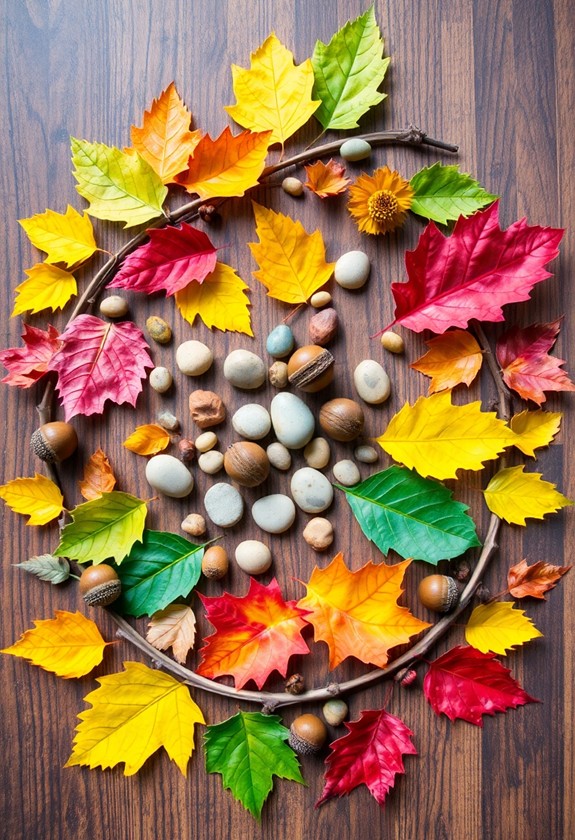
Take your toddler on a sensory-rich nature walk to collect materials for an exciting art project. Grab a bag and investigate together! Hunt for colorful leaves, smooth pebbles, fluffy dandelions, and crunchy twigs. Let your little one touch, smell, and examine each treasure.
Back home, it's time to create! Spread out your nature bounty and watch your toddler's eyes light up. Here are some fun ideas:
- Leaf rubbings: Place leaves under paper and rub with crayons
- Pebble painting: Decorate rocks with bright colors
- Twig frames: Glue twigs to cardboard for a rustic picture frame
- Nature collage: Stick leaves and flowers on paper to make a scene
This hands-on activity is a sensory bonanza! It'll boost language skills as you chat about colors, textures, and shapes. Plus, it's a great way to bring the outdoors inside!
Curious Little Questions
How Do Sensory Art Activities Impact Brain Development in Toddlers?
Sensory art activities are like a super-boost for your toddler's brain! They're not just fun, they're brain-building powerhouses! Here's how they help:
- Stimulate multiple senses at once
- Encourage creativity and problem-solving
- Boost fine motor skills and hand-eye coordination
- Improve neural connections
Your little one's brain is like a sponge, soaking up every colorful, squishy, and tactile experience. These activities are literally shaping their noggin, helping them grow smarter and more creative. It's like a brain gym for tots!
What Age Is Best to Start Introducing Sensory Art Activities?
Did you know that 90% of a child's brain development happens before age 5? That's why it's never too early to start sensory art activities! You can begin as soon as your little one can sit up and grasp objects, usually around 6-9 months. But don't worry if you're starting later – any time is a good time! Just remember, safety first! Always supervise and choose age-appropriate materials. Get ready to watch your toddler's creativity bloom and their language skills soar!
Can Sensory Art Activities Help With Developmental Delays or Disorders?
Yes, sensory art activities can be amazing for kids with developmental delays or disorders! They're like an enhanced boost for learning and growth. Here's why they're so awesome:
- Stimulate multiple senses at once
- Encourage exploration and curiosity
- Improve fine motor skills
- Boost communication and social interaction
- Reduce anxiety and promote relaxation
Whether it's finger painting, play dough, or sensory bins, these activities can work wonders! They're fun, engaging, and tailored to each child's needs. So, get creative and watch your little one blossom!
How Often Should Parents Engage in Sensory Art Activities With Toddlers?
You'd think parents should engage in sensory art activities with toddlers every second of every day, right? Wrong! But don't worry, it's not that extreme. Aim for 2-3 times a week, for about 15-20 minutes each session. It's all about quality, not quantity! Mix it up with different textures, colors, and materials. Remember, these activities should be fun, not forced. Let your little one lead the way, and watch their creativity bloom!
Are There Any Potential Risks or Allergies Associated With Sensory Art Materials?
You bet there are risks with sensory art materials! Watch out for these potential hazards:
- Allergens: Some kids might be allergic to ingredients in paints, doughs, or glues.
- Choking: Small items like beads or pom-poms can be dangerous for little ones.
- Toxicity: Make certain materials are non-toxic and safe if ingested.
- Skin irritation: Certain substances may cause rashes or itching.
But don't worry! With proper supervision and age-appropriate materials, sensory art can be a blast! Just keep an eye out and have fun creating masterpieces together!

